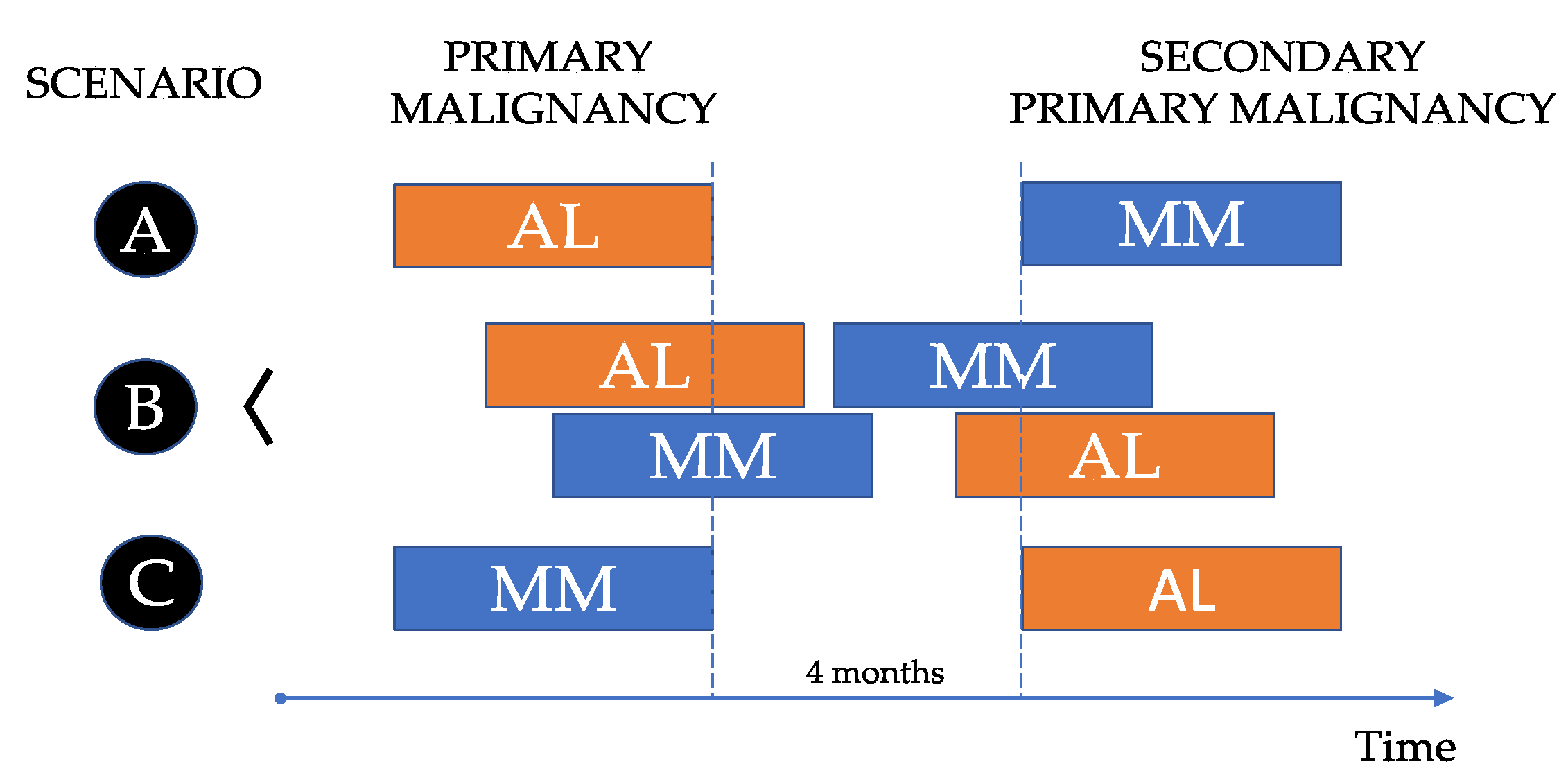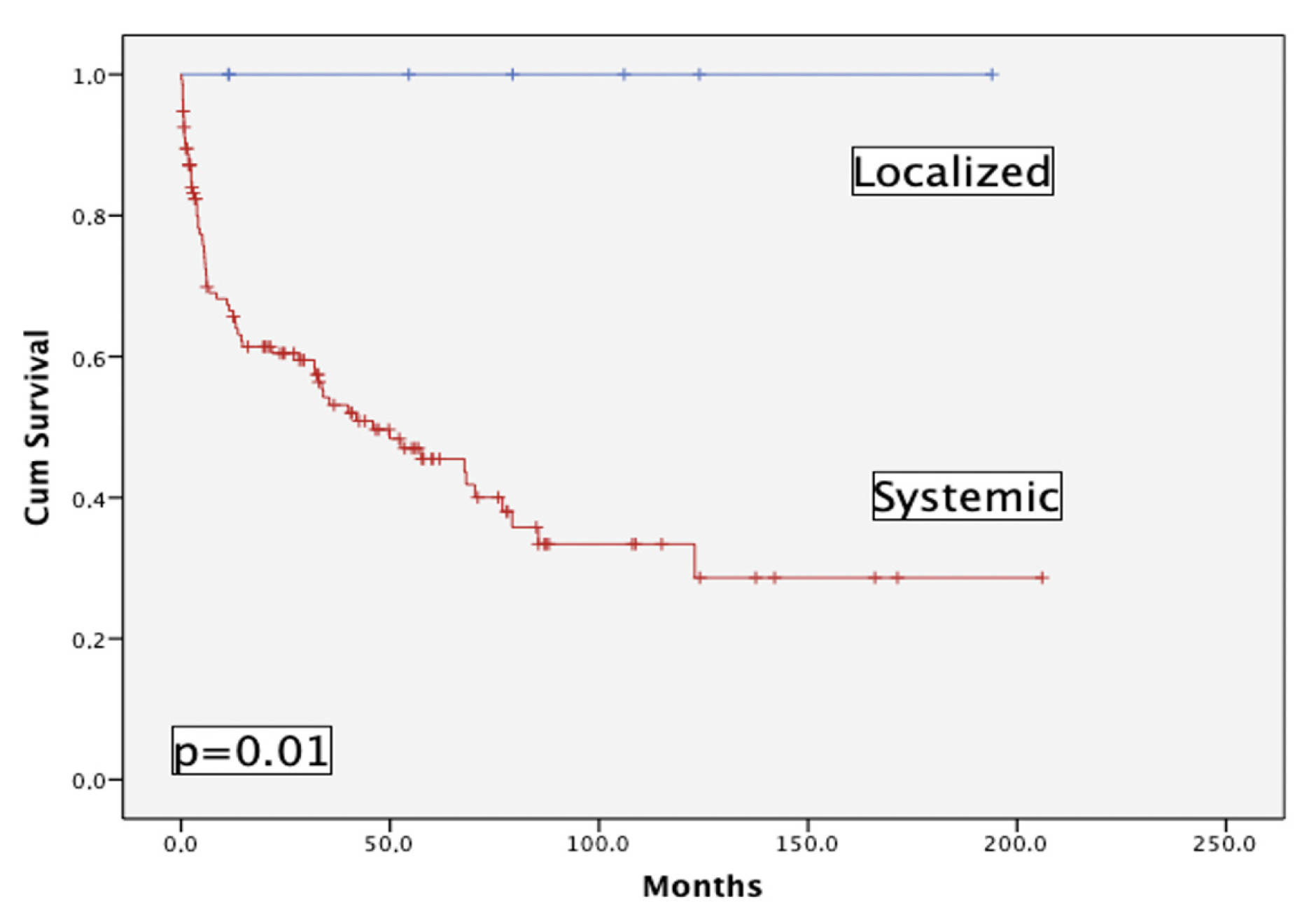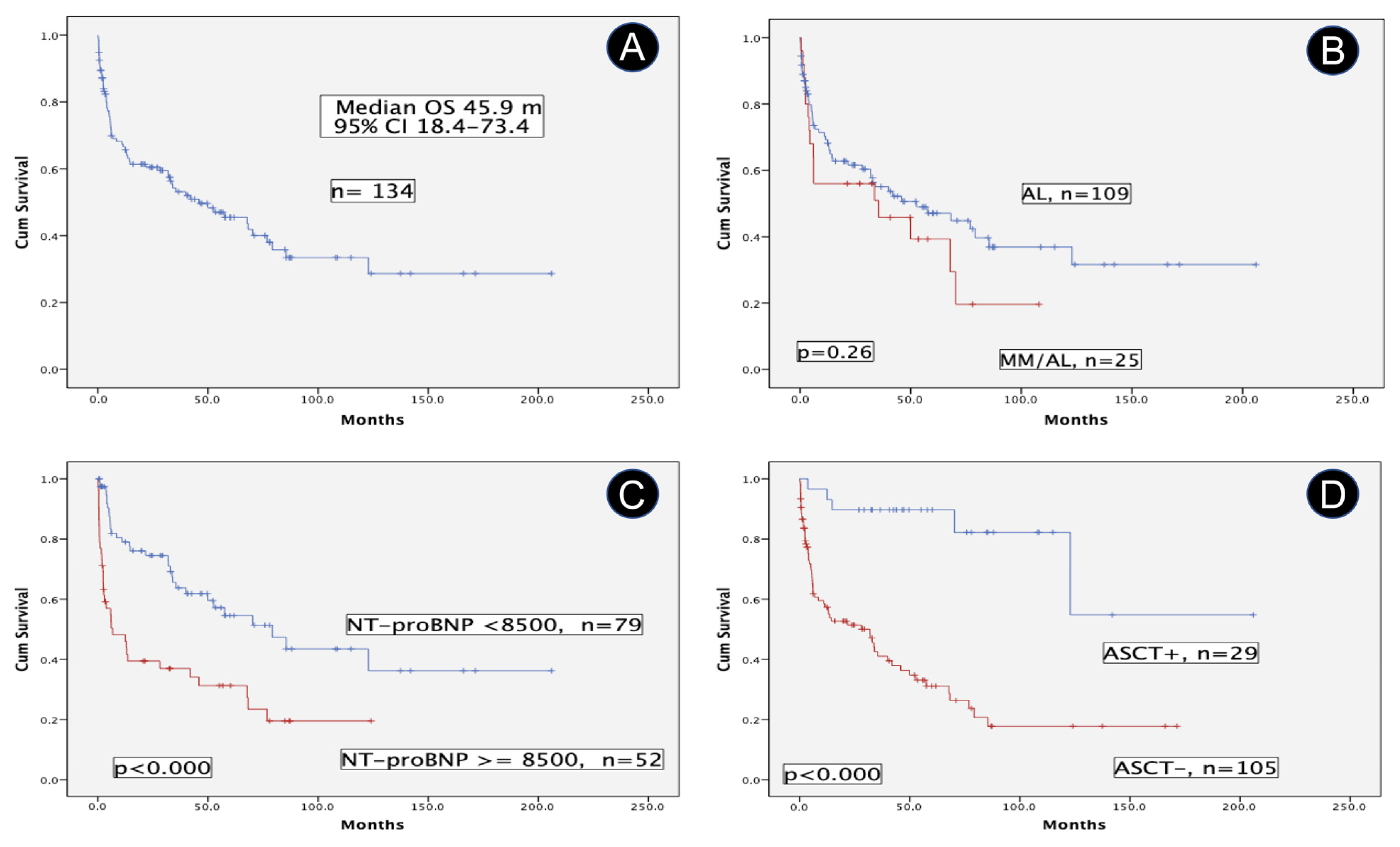AL Amyloidosis and Multiple Myeloma: A Complex Scenario in Which Cardiac Involvement Remains the Key Prognostic Factor
Abstract
1. Introduction
- A.
- Patients (pts) diagnosed with AL that develop MM in the future as a second primary malignancy.
- B.
- Pts diagnosed with AL and MM at the same time, synchronously.
- C.
- Pts diagnosed with MM in which AL appears later as a second primary malignancy.
2. Materials and Methods
2.1. Patients
2.2. Variables
2.3. End-Points
2.4. Statistics
3. Results
3.1. Localized versus Systemic AL Amyloidosis
3.2. Systemic AL Amyloidosis
3.3. AL Amyloidosis with Concurrent MM
4. Discussion
5. Conclusions
Author Contributions
Funding
Institutional Review Board Statement
Informed Consent Statement
Data Availability Statement
Acknowledgments
Conflicts of Interest
References
- Ríos-Tamayo, R. Monoclonal gammopathies. In Comprehensive Hematology and Stem Cell Research, 1st ed.; Rezaei, N., Ed.; Elsevier: Berkeley, CA, USA, 2023; submitted. [Google Scholar]
- Alaggio, R.; Amador, C.; Anagnostopoulos, I.; Attygalle, A.D.; de Oliveira Araujo, I.B.; Berti, E.; Bhagat, G.; Borges, A.M.; Boyer, D.; Calaminici, M.; et al. The 5th edition of the World Health Organization Classification of Haematolymphoid Tumours: Lymphoid Neoplasms. Leukemia 2022, 36, 1720–1748. [Google Scholar] [CrossRef] [PubMed]
- Rajkumar, S.V.; Gertz, M.A.; Kyle, R.A. Primary Systemic Amyloidosis with Delayed Progression to Multiple Myeloma. Cancer 1998, 82, 1501–1505. [Google Scholar] [CrossRef]
- Madan, S.; Dispenzieri, A.; Lacy, M.Q.; Buadi, F.; Hayman, S.R.; Zeldenrust, S.R.; Rajkumar, S.V.; Gertz, M.A.; Kumar, S.K. Clinical Features and Treatment Response of Light Chain (AL) Amyloidosis Diagnosed in Patients With Previous Diagnosis of Multiple Myeloma. Mayo Clin. Proc. 2010, 85, 232–238. [Google Scholar] [CrossRef]
- Mellqvist, U.H.; Cai, Q.; Hester, L.L.; Grövdal, M.; Börsum, J.; Rahmann, I.; Ammannn, E.M.; Hansson, M. Light-Chain Amyloidosis in Sweden (2011–2019): Incidence, Disease Burden, and Clinical Outcomes in Real-World Patients. Blood 2022, 140 (Suppl. 1), 5230–5231. [Google Scholar] [CrossRef]
- Pardanani, A.; Witzig, T.E.; Schroeder, G.; McElroy, E.A.; Fonseca, R.; Dispenzieri, A.; Lacy, M.Q.; Lust, J.A.; Kyle, R.A.; Greipp, P.R.; et al. Circulating peripheral blood plasma cells as a prognostic indicator in patients with primary systemic amyloidosis. Blood 2003, 101, 827–830. [Google Scholar] [CrossRef] [PubMed]
- Kourelis, T.V.; Kumar, S.K.; Gertz, M.A.; Lacy, M.Q.; Buadi, F.K.; Hayman, S.R.; Zeldenrust, S.; Leung, N.; Kyle, R.A.; Russell, S.; et al. Coexistent Multiple Myeloma or Increased Bone Marrow Plasma Cells Define Equally High-Risk Populations in Patients With Immunoglobulin Light Chain Amyloidosis. J. Clin. Oncol. 2013, 34, 4319–4324. [Google Scholar] [CrossRef] [PubMed]
- Dinner, S.; Witteles, W.; Witteles, R.; Lam, A.; Arai, S.; Lafayette, R.; George, T.I.; Schrier, S.I.; Liedtke, M. The prognostic value of diagnosing concurrent multiple myeloma in immunoglobulin light chain amyloidosis. Br. J. Haematol. 2013, 161, 367–372. [Google Scholar] [CrossRef]
- Jimenez-Zepeda, V.H.; Reece, D.; Rigo, R.; Gogna, P.; Kong, S.; Yang Hu, X.; Chapani, P.; Cheung, W.Y.; Brenner, D.R.; Plante, R.; et al. Understanding real-world treatment patterns and clinical outcomes in AL amyloidosis patients diagnosed in Canada: A population-based cohort study. eJHaem 2022, 3, 1262–1269. [Google Scholar] [CrossRef]
- Yoon, S.E.; Kim, D.; Choi, J.O.; Min, J.H.; Joon Kim, B.; Kim, J.S.; Eun Lee, J.; Young Choi, J.; Jeon, E.S.; Jin Kim, S.; et al. A comprehensive overview of AL amyloidosis disease characteristics accumulated over two decades at a single referral center in Korea. Int. J. Hematol. 2022, 117, 706–717. [Google Scholar] [CrossRef]
- He, H.; Lu, J.; Qiang, W.; Liu, J.; Liang, A.; Du, J. The Landscape of Cytogenetic Aberrations in Light-Chain Amyloidosis with or without Coexistent Multiple Myeloma. J. Clin. Med. 2023, 12, 1624. [Google Scholar] [CrossRef]
- Vela-Ojeda, J.; García-Ruiz Esparza, M.A.; Padilla-González, Y.; Sánchez-Cortés, E.; García-Chavez, J.; Montiel-Cervantes, L.; Reyes-Maldonado, E.; Majluf-Cruz, A.; Mayani, H. Multiple myeloma-associated amyloidosis is an independent high-risk prognostic factor. Ann. Hematol. 2009, 88, 59–66. [Google Scholar] [CrossRef] [PubMed]
- Siragusa, S.; Morice, W.; Gertz, M.A.; Kyle, R.A.; Greipp, P.R.; Lust, J.A.; Witzig, T.E.; Lacy, M.Q.; Zeldenrust, S.R.; Rajkumar, S.V.; et al. Asymptomatic immunoglobulin light chain amyloidosis (AL) at the time of diagnostic bone marrow biopsy in newly diagnosed patients with multiple myeloma and smoldering myeloma. A series of 144 cases and a review of the literature. Ann. Hematol. 2011, 90, 101–106. [Google Scholar] [CrossRef]
- Usnarska-Zubkiewicz, L.; Holojda, J.; Jelen, M.; Zubkiewicz-Zarebska, A.; Debski, J.; Kuliczkowski, K. The Occurrence of AL Amyloidosis (Light-Chain Amyloidosis) in Patients with Multiple Myeloma in Lower Silesia Region, Poland. Adv. Clin. Exp. Med. 2014, 23, 235–244. [Google Scholar] [CrossRef]
- Ríos-Tamayo, R.; Sánchez, M.J.; Puerta, J.M.; Sainz, J.; Chang-Chan, D.Y.; Rodríguez, T.; López, P.; de Pablos, J.M.; Navarro, P.; García de Veas, J.L.; et al. Trends in survival of multiple myeloma: A thirty-year population-based study in a single institution. Cancer Epidemiol. 2015, 39, 693–699. [Google Scholar] [CrossRef]
- Xu, J.; Wang, M.; Shen, Y.; Yan, M.; Xie, W.; Wang, B.; Liu, H.; Cen, X. Effects of Amyloid Light-Chain Amyloidosis on Clinical Characteristics and Prognosis in Multiple Myeloma: A Single-Center Retrospective Study. Cancer Manag. Res. 2021, 13, 1343–1356. [Google Scholar] [CrossRef]
- Rajkumar, S.V.; Dimopoulos, M.A.; Palumbo, A.; Blade, J.; Merlini, G.; Mateos, M.V.; Kumar, S.; Hillengass, J.; Kastritis, E.; Richardson, P.; et al. International Myeloma Working Group updated criteria for the diagnosis of multiple myeloma. Lancet Oncol. 2014, 15, e538–e548. [Google Scholar] [CrossRef]
- Chang-Chan, D.Y.; Ríos-Tamayo, R.; Rodríguez-Barranco, M.; Redondo-Sánchez, D.; González, Y.; Marcos-Gragera, R.; Sánchez, M.J. Trends of incidence, mortality and survival of multiple myeloma in Spain. A twenty-three-year population-based study. Clin. Trans. Oncol. 2021, 23, 1429–1439. [Google Scholar] [CrossRef]
- Estimaciones de la incidencia del cáncer en España, 2021. Red Española de Registros de Cáncer (REDECAN), 2021. Available online: https://stage.redecan.org/storage/documents/b05bfad2-4b48-4519-9f56-6aad911e80b0.pdf (accessed on 4 May 2023).
- Kumar, N.; Zhang, N.J.; Cherepanov, D.; Romanus, D.; Hughes, M.; Faller, D.V. Global epidemiology of amyloid light-chain amyloidosis. Orphanet J. Rare Dis. 2022, 17, 278. [Google Scholar] [CrossRef] [PubMed]
- Baicry, F.; Molinié, F.; Plouvier, S.; Colonna, M.; Daubisse-Marliac, L.; Grosclaude, P.; Trétarre, B.; Bara, S.; Lapôtre-Ledoux, B.; Woronoff, A.S.; et al. What is the most appropriate period to define synchronous cancers? Cancer Epidemiol. 2021, 71, 101900. [Google Scholar] [CrossRef] [PubMed]
- Vergaro, G.; Aimo, A.; Barison, A.; Genovesi, D.; Buda, G.; Passino, C.; Emdin, M. Keys to early diagnosis of cardiac amyloidosis: Red flags from clinical, laboratory and imaging findings. Eur. J. Prev. Cardiol. 2020, 27, 1806–1815. [Google Scholar] [CrossRef] [PubMed]
- Palladini, G.; Schönland, S.; Merlini, G.; Milani, P.; Jaccard, A.; Bridoux, F.; Dimopoulos, M.A.; Ravichadran, S.; Hegenbart, U.; Roeloffzen, W.; et al. The management of light chain (AL) amyloidosis in Europe: Clinical characteristics, treatment patterns, and efficacy outcomes between 2004 and 2018. Blood Cancer J. 2023, 13, 19. [Google Scholar] [CrossRef] [PubMed]
- Garcia-Pavia, P.; Rapezzi, C.; Adler, Y.; Arad, M.; Basso, C.; Brucato, A.; Burazor, I.; Caforio, A.L.P.; Damy, T.; Eriksson, U.; et al. Diagnosis and treatment of cardiac amyloidosis: A position statement of the ESC Working Group on Myocardial and Pericardial Diseases. Eur. Heart J. 2021, 42, 1554–1568. [Google Scholar] [CrossRef] [PubMed]



| Author/Year | Period | Primary Disease | N | n (%N) |
|---|---|---|---|---|
| Pardadani, A. et al., 2003 [6] | 1991–1996 | AL | 147 | 20 MM (14) |
| Kourelis, T.V. et al., 2013 [7] | 2000–2010 | AL | 1255 | 100 MM (8) |
| Dinner, S. et al., 2013 [8] | 2005–2011 | AL | 46 | 21/37 MM (57) |
| Jimenez-Zepeda, V. et al., 2022 [9] | 2010–2019 | AL | 215 | 64 MM (29.8) |
| Yoon. S.E. et al., 2022 [10] | 1995–2018 | AL | 302 | 59 MM (19.5) |
| He, H. et al., 2023 [11] | 2012–2021 | AL | 142 | 62 MM (43.7) |
| Vela-Ojeda, J. et al., 2009 [12] | 1989–2000 | MM | 201 | 68 AL (33.8) |
| Siragusa, S. et al., 2011 [13] | 1993–2003 | MM/SMM | 144 | 2 * AL (1.4) |
| Usnarka-Zubkiewicz, L. et al., 2014 [14] | ND | MM | 70 | 18 AL (25.7) |
| Ríos-Tamayo, R. et al., 2015 [15] | 1985–2014 | MM | 303 | 7 AL (2.3) |
| Xu, J. et al., 2021 [16] | 2010–2018 | MM/SMM | 158 | 49 AL (31) |
| Variable | MM/AL (n = 25) | AL (n = 109) | p Value |
|---|---|---|---|
| Age, years | |||
| mean (SD) | 61.60 (13.11) | 64.94 (11.61) | ns |
| median (IQR) | 61 (53–72) | 65 (55–74) | - |
| Sex, % men | 56 | 53.2 | ns |
| ECOG 3–4, % | 48 | 34.9 | ns |
| Weight loss, % | 40 | 30.3 | ns |
| Diagnostic delay, mean (SD), months | 6.58 (3.92) | 8.02 (4.59) | ns |
| M-protein s mean (SD), g/dL | 0.52 (0.82) | 0.39 (0.65) | ns |
| M-protein s Biclonal, % | 16 | 8.3 | ns |
| FLCr (i/u) mean (SD) | 173.58 (160.82) | 32.78 (78.64) | 0.000 |
| FLCd mean (SD) | 1337.47 (1211.73) | 510.76 (1075.63) | 0.002 |
| Creatinine s mean (SD), mg/dL | 1.01 (0.28) | 1.32 (1.25) | 0.029 |
| 24-h urine proteinuria mean (SD), g | 3.20 (6.60) | 2.87 (4.11) | ns |
| Heart involvement, % | 92 | 89.9 | ns |
| NT-proBNP mean (SD), pg/mL | 9912 (16,974.82) | 8811 (10,927.64) | ns |
| Troponin I mean (SD), ng/L | 0.10 (0.07) | 0.31 (0.83) | ns |
| LVEF %, mean (SD), | 51.69 (12.77) | 56.03 (12.27) | ns |
| Mayo 2012, IV, % | 44 | 40.4 | ns |
| Mayo 2004 mod. 2015, IIIb, % | 28 | 26.6 | ns |
| BMPC, mean % | 37.16 | 18.02 | 0.000 |
| BMI, mean (SD), Kg/m2 | 24.15 (3.02) | 25.60 (3.86) | 0.057 |
| Num.comorbidities, mean (SD) | 2.33 (1.74) | 2.74 (1.90) | ns |
| Num.organs, mean (SD) | 2.56 (1.29) | 2.57 (1.11) | ns |
| Immunoparesis, % | 95 | 76.7 | 0.064 |
| Macroglossia, % | 28 | 22.9 | ns |
| CTS, % | 28 | 14.7 | ns |
| Prior MGUS, % | 8.3 | 9.4 | ns |
| ASCT, % | 7/25 (28%) | 22/109 (20.2%) | ns |
| Prior cancer, % | 20.8 | 11.4 | ns |
| Univariate Analysis | Cox Regression Model | |||||
|---|---|---|---|---|---|---|
| Variables | HR | 95% CI | p | HR | 95% CI | p |
| Age, years | 1.05 | 1.03–1.08 | 0.000 | 1.05 | 1.02–1.08 | 0.001 |
| ECOG 0–2 (vs. 3–4) | 0.53 | 0.33–0.85 | 0.008 | - | ||
| NT-proBNP < 8500 (vs. ≥8500) | 2.63 | 1.63–4.25 | 0.000 | 2.09 | 1.25–3.51 | 0.005 |
| LVEF, % | 0.98 | 0.96–0.99 | 0.036 | 0.98 | 0.96–1.00 | 0.06 |
| BMPC, % | 1.01 | 1.00–1.03 | 0.029 | - | ||
| Number of comorbidities | 1.23 | 1.07–1.40 | 0.002 | - | ||
| ASCT | 0.15 | 0.06–0.37 | 0.000 | 0.30 | 0.10–0.88 | 0.029 |
| MM | 1.38 | 0.78–2.42 | 0.265 | - | ||
Disclaimer/Publisher’s Note: The statements, opinions and data contained in all publications are solely those of the individual author(s) and contributor(s) and not of MDPI and/or the editor(s). MDPI and/or the editor(s) disclaim responsibility for any injury to people or property resulting from any ideas, methods, instructions or products referred to in the content. |
© 2023 by the authors. Licensee MDPI, Basel, Switzerland. This article is an open access article distributed under the terms and conditions of the Creative Commons Attribution (CC BY) license (https://creativecommons.org/licenses/by/4.0/).
Share and Cite
Ríos-Tamayo, R.; Krsnik, I.; Gómez-Bueno, M.; Garcia-Pavia, P.; Segovia-Cubero, J.; Huerta, A.; Salas, C.; Silvestre, R.Á.; Sánchez, A.; Manso, M.; et al. AL Amyloidosis and Multiple Myeloma: A Complex Scenario in Which Cardiac Involvement Remains the Key Prognostic Factor. Life 2023, 13, 1518. https://doi.org/10.3390/life13071518
Ríos-Tamayo R, Krsnik I, Gómez-Bueno M, Garcia-Pavia P, Segovia-Cubero J, Huerta A, Salas C, Silvestre RÁ, Sánchez A, Manso M, et al. AL Amyloidosis and Multiple Myeloma: A Complex Scenario in Which Cardiac Involvement Remains the Key Prognostic Factor. Life. 2023; 13(7):1518. https://doi.org/10.3390/life13071518
Chicago/Turabian StyleRíos-Tamayo, Rafael, Isabel Krsnik, Manuel Gómez-Bueno, Pablo Garcia-Pavia, Javier Segovia-Cubero, Ana Huerta, Clara Salas, Ramona Ángeles Silvestre, Amelia Sánchez, Marta Manso, and et al. 2023. "AL Amyloidosis and Multiple Myeloma: A Complex Scenario in Which Cardiac Involvement Remains the Key Prognostic Factor" Life 13, no. 7: 1518. https://doi.org/10.3390/life13071518
APA StyleRíos-Tamayo, R., Krsnik, I., Gómez-Bueno, M., Garcia-Pavia, P., Segovia-Cubero, J., Huerta, A., Salas, C., Silvestre, R. Á., Sánchez, A., Manso, M., Delgado, L., Lahuerta, J. J., Martínez-López, J., & Duarte, R. F. (2023). AL Amyloidosis and Multiple Myeloma: A Complex Scenario in Which Cardiac Involvement Remains the Key Prognostic Factor. Life, 13(7), 1518. https://doi.org/10.3390/life13071518








